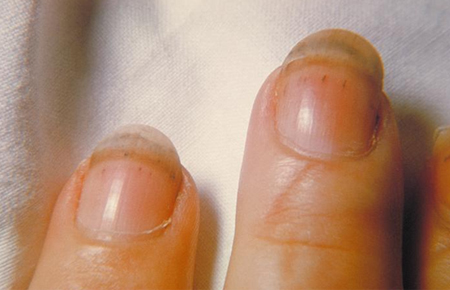History and exam
Key diagnostic factors
common
consumption of raw or undercooked meat
Trichinellosis is acquired by the consumption of raw or undercooked meat infected with the Trichinella parasite.
The incubation period for trichinellosis following the ingestion of raw or undercooked meat is directly proportional to the acquired parasitic load and ranges from 1-2 days (enteral phase) to 2-8 weeks (parenteral phase) or more, depending on the infectious dose.[34]
The dramatic drop in cases of trichinellosis related to the consumption of pigs in the US is attributed to increased levels of biosecurity and hygiene in the production of pork meat.
sick contacts
Trichinellosis tends to occur in outbreaks affecting households or communities that have consumed meat from the same source.[45] There is no risk of human-to-human transmission.
myalgia and myositis
Observed in most patients in the systemic (parenteral) phase of the disease, although the percentage of those affected varies between outbreaks.
Myalgia can be so severe that it prevents patients from moving and impairs the ability to chew, swallow, breathe, or talk depending on the muscles involved. The severity of myalgia usually correlates with the degree of eosinophilia.[44]
fever
periorbital/facial edema
Other diagnostic factors
common
subungual and retinal splinter hemorrhages
Splinter hemorrhages can occur on the nail beds and/or the retina.[Figure caption and citation for the preceding image starts]: Trichinellosis manifested by splinter hemorrhages under the finger nailsCDC/Dr Thomas F. Sellers, Emory University [Citation ends].
other ocular features
Edema of the eyelids, chemosis, disturbed vision, ocular pain, and paralysis of the ocular muscles have been described.[32]
uncommon
gastrointestinal signs and symptoms
Include nausea, vomiting, abdominal pain, and diarrhea. May occur during the gastrointestinal (enteric) phase of the disease when the larvae penetrate the intestinal wall.[46]
hepatomegaly
Infrequent finding in patients with severe disease, potentially due to direct invasion of the parasite or a consequence of congestive heart failure in complicated trichinellosis.
Only in extremely rare cases is it associated with jaundice.[64]
oliguria
Nephritis may occur in severe cases.[63]
maculopapular rash
A nonspecific maculopapular rash is most probably due to parasite-induced vasculitis.[48]
other cutaneous features
Pruritus, sweating, and the sensation of crawling insects beneath the skin have been described.[48]
dysphagia
A manifestation of severe muscle involvement.
dysphonia
A manifestation of severe muscle involvement.
dyspnea
A manifestation of severe muscle involvement.
It may also be secondary to congestive cardiac failure resulting from myocarditis complicating the infection.
headache
Although an uncommon feature overall, headache is a common neurologic manifestation of trichinellosis.
paralysis-like state
Secondary to severe muscle weakness and apathy.
Risk factors
strong
consumption of raw or undercooked pork
Trichinellosis is acquired by the consumption of raw or undercooked meat infected with the Trichinella parasite.[10][11]
In a 2017 outbreak, the consumption of larb (a traditional Laotian raw pork dish) was significantly associated with trichinellosis, with an attack rate of 100% and a relative risk of 3.33 (95% CI 1.29 to 8.59).[29] No other meat dishes served at the event were associated with an increased relative risk for trichinellosis.
The dramatic drop in cases of trichinellosis related to the consumption of pigs in the US is attributed to increased levels of biosecurity and hygiene in the production of pork meat.
consumption of raw or undercooked horse or other domestic animal meat
Trichinellosis is acquired by the consumption of raw or undercooked meat infected with the Trichinella parasite.
Human trichinellosis due to insufficiently cooked horse meat consumption has been reported in France and in Italy.[30][31]
Rarely, other herbivores (cattle, sheep) have been associated with trichinellosis outbreaks via contamination or adulteration of their meat.[32]
consumption of raw or undercooked wild game meat
Trichinellosis is acquired by the consumption of raw or undercooked meat infected with the Trichinella parasite.
Although human trichinellosis is traditionally associated with the consumption of infected pork, stringent regulations of pork meat processing have made wild game meat the most common source of infection in the US and Canada. Most cases are associated with eating bear, cougar, wildcat, fox, wolf, seal, walrus, or boar meat.[10][11][33][34]
weak
consumption of raw or undercooked reptile meat
Trichinellosis is acquired by the consumption of raw or undercooked meat infected with the Trichinella parasite.
Occasionally the disease has been acquired by ingestion of reptile meat, including turtles and lizards.[23]
Use of this content is subject to our disclaimer